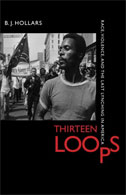Thirteen Loops: Race, Violence, and the Last Lynching in America

Author: B.J. Hollars
Publisher: Tuscaloosa, AL: University of Alabama Press, 2011. 237 p.
Reviewer: William M. Anderson Jr. | March 2012
Thirteen Loops, which refers to the number of knots a noose needs to sustain the weight of its victim, takes the reader across Alabama from Tuscaloosa to Birmingham to Mobile, telling the story of the last lynching in America. Moving from the 1930s into the late 1970s, B. J. Hollars uses the interconnectedness of three violent murders to shed light on the cultural fears and biases of people living in the southern United States. While the text makes it clear that the author detests violence, it does not resort to sensationalism or hyperbole, giving an objective historical analysis of the occurrences leading up to the last lynching in 1981. In addition, the story strives at avoiding lavish declarations that suggest definitive answers to questions surrounding racial violence. Upon finishing the book, the reader is, however, left with more questions than answers about the sociological understanding of racism in the south.
The book chronicles three violent Alabama murders that became circuitous investigations composed of false accusations, cover-ups, and the unveiling of the Ku Klux Klan. Using archived newspaper articles and interviews from the Southern Poverty Law Center, Thirteen Loops begins with the historical context surrounding the murder of Vaudine Maddox in 1933. Vaudine, a poor white woman, was found stoned to death. Her murder resulted in the lynching of three youthful black male suspects who had not been found guilty in a legal proceeding in a court of law. This case serves as a premonition for the violence that would occur nearly fifty years later. Hollars concludes that the Maddox case acts “as a lens to support the historical framework of lynching and a much needed backdrop for the other victims.”
The second case detailed by Hollars occurred in 1979. Gene Ballard, a white police officer and family man, was shot and killed while investigating a foiled bank robbery in Birmingham. Two years following his death, his murderer Josephus Anderson, a wanted African American with a history of deviance, was freed on a mistrial. The mistrial sparked a violent retaliation that resulted in the lynching of an innocent nineteen-year-old man in Mobile. Hanged by two admitted Klansmen, Michael Donald’s story becomes the third case covered in Hollars’ book. This event sparked a lengthy investigation that resulted in a wrongful death suit on behalf of Michael’s mother — a suit that bankrupted the United Klans of America faction. This court case would serve as a foundation for other legal cases against racist groups across America. Throughout the tripartite saga, Hollars draws connections among the cases in an effort to demonstrate examples of racial murders that found no justice, presenting a clear comparison to the Donald murder where justice of a sort was finally served.
Upon finishing the book, the reader is left with the surprising revelation that lynching certainly has not ceased, even in the twenty-first century. Hollars compares the death of Michael Donald to that of Matthew Shepard in 1998, arguing that the only thing that has changed is the name of the crime. It appears the term “lynching” is too archaic for the twenty first century — which is why the media and the court system have apparently chosen to leave the term lynching with the death of Michael Donald, and adopt the legal term “hate crime” for the Matthew Shepard case.
Interesting and well researched, the book provides an in-depth analysis of the death of Michael Donald and the events that led up to it. One is left to speculate, however, whether the racially driven connections described by Hollars were indicative of racial violence in the south as a whole, and not just in Alabama.
William M. Anderson Jr. is a Graduate Student at Rutgers University School of Criminal Justice.


